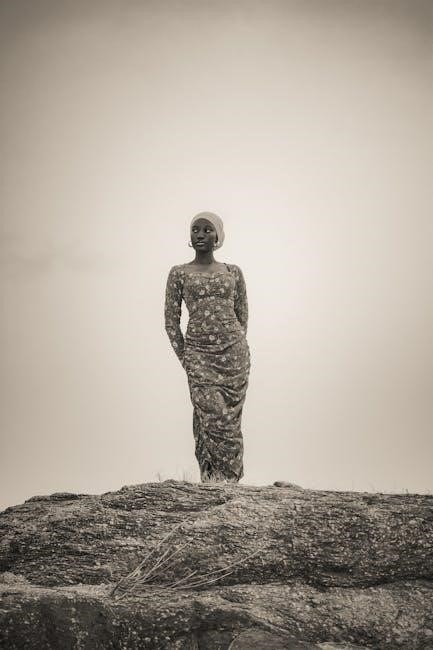The Drama Triangle, introduced by Stephen Karpman, is a Transactional Analysis model that identifies three roles—Victim, Rescuer, and Persecutor—shaping dysfunctional interactions and unconscious patterns.
1.1. Definition and Overview
The Drama Triangle, developed by Stephen Karpman, is a psychological model within Transactional Analysis that outlines three distinct roles: Victim, Rescuer, and Persecutor. These roles represent recurring patterns in interpersonal conflicts, where individuals unconsciously adopt positions that perpetuate dysfunctional dynamics. The model serves as a tool to identify and transform unproductive interactions, fostering awareness and healthier communication. It is widely used in psychotherapy and personal development to address recurring emotional and relational challenges.
1.2. Historical Context in Transactional Analysis
The Drama Triangle originated from Transactional Analysis (TA), a psychotherapeutic approach developed by Eric Berne. Stephen Karpman further refined this concept in 1968, introducing the Victim, Rescuer, and Persecutor roles. Rooted in Berne’s theory of ego states, the Drama Triangle became a cornerstone in TA, offering insights into repetitive, unconscious patterns in human interactions. Its evolution has made it a vital tool for understanding and addressing relational conflicts in therapy and personal growth.
Key Roles in the Drama Triangle
The Drama Triangle consists of three key roles: Victim, Rescuer, and Persecutor, each representing distinct positions in a dysfunctional interaction cycle.
2.1. The Victim
The Victim is the first role in the Drama Triangle, characterized by feelings of powerlessness and helplessness. This role often seeks sympathy and salvation from others, believing they are incapable of solving their problems. Victims may adopt a passive stance, fostering dependency and avoiding responsibility. Their behavior can perpetuate the cycle of drama by inviting Rescuers to intervene.
2.2. The Rescuer
The Rescuer is the second role in the Drama Triangle, often assuming a helper position by trying to solve the Victim’s problems. This role can stem from a desire to feel needed or morally superior. While Rescuers may appear altruistic, their actions can unintentionally disempower the Victim, reinforcing dependency. The Rescuer may also have unconscious motives, such as avoiding their own issues or gaining emotional fulfillment through helping others.
2.3. The Persecutor
The Persecutor is the third role in the Drama Triangle, typically adopting a controlling or critical stance, shifting responsibility onto others. This role often emerges when individuals feel threatened or vulnerable, leading them to blame or attack others to maintain power. The Persecutor’s actions reinforce the Victim’s helplessness and the Rescuer’s need to intervene, perpetuating dysfunctional cycles. This role can stem from unconscious patterns of defense or fear of vulnerability.

Dynamics of the Drama Triangle
3.1. Role Switching in Interactions
Role switching occurs when individuals shift between Victim, Rescuer, and Persecutor roles, often unconsciously, in response to changing dynamics, perpetuating the cycle of dysfunction.

Role switching in the Drama Triangle occurs when individuals shift between Victim, Rescuer, and Persecutor roles during interactions. This dynamic can happen rapidly and unconsciously, often in response to changing circumstances or emotional states. The Victim may suddenly become a Persecutor, while the Rescuer might feel victimized, perpetuating the cycle of dysfunction. Understanding these shifts is crucial for breaking free from the triangle’s constraints and fostering healthier communication patterns.

3.2. The Impact of Unconscious Patterns
Unconscious patterns in the Drama Triangle significantly influence interactions, perpetuating cycles of dysfunction. These ingrained behaviors, often rooted in past experiences, lead individuals to adopt roles like Victim, Rescuer, or Persecutor without awareness. Such patterns hinder personal growth and healthy relationships by reinforcing negative dynamics. Recognizing these unconscious tendencies is essential for breaking free and fostering constructive communication, ultimately promoting emotional well-being and more balanced interactions.

The Drama Triangle in Transactional Analysis Literature
The Drama Triangle, introduced by Stephen Karpman in 1968, is a core concept in Transactional Analysis, analyzing dysfunctional interactions through Victim, Rescuer, and Persecutor roles, linking games and scripts.
4.1. Eric Berne’s Contribution to TA
Eric Berne, the founder of Transactional Analysis, laid the groundwork for understanding human interactions through ego states and transactions. His seminal work, Transactions in Action, defined TA’s core principles, influencing the development of the Drama Triangle. Berne’s theories on structural analysis and transactional patterns provided the theoretical foundation for later concepts like the Drama Triangle, shaping modern psychotherapy practices and communication strategies.
4.2. Stephen Karpman’s Formulation of the Triangle
Stephen Karpman introduced the Drama Triangle in 1968, building on Eric Berne’s Transactional Analysis. He identified three roles—Victim, Rescuer, and Persecutor—that recur in dysfunctional interactions. Karpman’s model, influenced by fairy tales, provides a visual framework to understand unconscious patterns. His work revolutionized TA by offering a practical tool to analyze and transform harmful relationship dynamics, emphasizing the cyclical nature of these roles in conflict situations.

Case Studies and Applications
Case studies highlight the Drama Triangle’s presence in fairy tales and professional settings, illustrating how roles like Victim, Rescuer, and Persecutor manifest in real-life conflicts and dynamics.

5.1. Fairy Tales as Examples of the Drama Triangle
Fairy tales often illustrate the Drama Triangle, with characters embodying Victim, Rescuer, or Persecutor roles. For example, Cinderella depicts the Victim (Cinderella), Persecutor (stepmother), and Rescuer (fairy godmother). These narratives reveal how individuals unconsciously adopt roles, perpetuating cycles of dependency and conflict. Analyzing these stories helps identify and transform dysfunctional patterns in real-life interactions, promoting healthier communication and relationships. The Drama Triangle’s universality is evident in these timeless tales.
5.2. Real-Life Scenarios in Professional Settings
The Drama Triangle frequently appears in workplace interactions, where roles like Victim, Rescuer, and Persecutor emerge. For example, an employee (Victim) may feel overwhelmed, a manager (Persecutor) pressures them, and a colleague (Rescuer) offers help. Such dynamics can create dependency and conflict, hindering productivity. Recognizing these patterns helps professionals adopt healthier communication strategies, fostering collaboration and reducing drama in team dynamics.

Breaking Free from the Drama Triangle
Breaking free involves recognizing and transforming dysfunctional roles. Stephen Karpman’s model highlights shifting from Victim, Rescuer, and Persecutor roles to foster healthy, empowered interactions and personal growth.
6.1. Recognizing Dysfunctional Patterns
Recognizing dysfunctional patterns begins with self-awareness, identifying the Victim, Rescuer, or Persecutor roles one plays. These roles, rooted in unconscious habits, perpetuate unproductive cycles. By acknowledging these dynamics, individuals can start to break free, fostering healthier interactions. Awareness is the first step toward transformation, allowing for a shift from reactive to proactive behaviors in personal and professional relationships.
6.2. Strategies for Transformation
Transforming from the Drama Triangle involves shifting to the Winner’s Triangle, focusing on awareness, responsibility, and empowerment. Practical strategies include self-reflection, open communication, and setting boundaries. Individuals can adopt roles like the Aware, the Solver, and the Coach, fostering healthy interactions. Mindfulness and emotional intelligence are key tools in breaking free from dysfunctional patterns and cultivating constructive relationships.

The Winner’s Triangle as an Alternative
The Winner’s Triangle, developed by Acey Choy, offers a healthier alternative to the Drama Triangle, promoting awareness, problem-solving, and collaboration to transform interactions.
7.1. Shifting from Drama to Healthy Interactions
Shifting from the Drama Triangle to healthy interactions involves recognizing dysfunctional patterns and adopting the Winner’s Triangle roles: Aware, Problem-Solver, and Collaborator. This model, introduced by Acey Choy, fosters mutual respect and cooperation, moving beyond victimhood, rescuing, or persecuting. By embracing these roles, individuals can transform conflicts into constructive dialogue, promoting personal growth and harmonious relationships. This approach encourages accountability, empathy, and shared solutions, breaking free from the cycle of drama.
- Roles in the Winner’s Triangle: Aware, Problem-Solver, Collaborator;
- Focus on mutual respect and shared responsibility.
- Encourages personal growth and constructive communication.
7.2. Practical Steps to Implement the Winner’s Triangle
The Winner’s Triangle, developed by Acey Choy, offers a pathway to healthier interactions by replacing the Drama Triangle’s roles with Aware, Problem-Solver, and Collaborator. To implement this, individuals must first recognize their default Drama Triangle roles and consciously shift their mindset. This involves embracing self-awareness, taking responsibility for problem-solving, and fostering collaboration through open communication. Practical steps include reflective journaling, seeking feedback, and practicing active listening to maintain balanced and constructive interactions.
- Reflect on personal tendencies in the Drama Triangle.
- Adopt the Aware, Problem-Solver, and Collaborator roles.
- Engage in active listening and open dialogue.

Therapeutic Uses of the Drama Triangle
The Drama Triangle is a therapeutic tool in Transactional Analysis, helping individuals identify and transform dysfunctional interaction patterns. Therapists use it to uncover unconscious roles—Victim, Rescuer, and Persecutor—that perpetuate conflicts, fostering self-awareness and healthier communication strategies. By recognizing these roles, clients can break free from limiting behaviors and adopt more constructive ways of relating, promoting personal growth and improved relationships.
8.1. Role of the Drama Triangle in Psychotherapy
The Drama Triangle plays a pivotal role in psychotherapy by helping clients identify and understand their unconscious roles—Victim, Rescuer, and Persecutor—that perpetuate dysfunctional interactions. Therapists use this model to reveal underlying patterns, enabling clients to recognize how they contribute to conflicts. By addressing these roles, individuals can break free from negative cycles, fostering healthier communication and emotional growth. This insight promotes self-awareness and empowers clients to adopt more constructive ways of relating to others.
8.2. Applications in Counseling and Coaching
The Drama Triangle is a powerful tool in counseling and coaching, helping individuals recognize and change destructive patterns. By identifying roles, clients gain self-awareness and develop healthier interactions. Coaches use it to enhance communication and leadership, fostering personal growth. Transactional Analysis provides the framework, enabling lasting transformation through practical techniques.
The Drama Triangle offers insights into dysfunctional interactions, aiding personal growth through self-awareness and transformation, enhancing relationships and psychotherapy effectiveness.
9.1. Summary of Key Points
The Drama Triangle, rooted in Transactional Analysis, explores three roles: Victim, Rescuer, and Persecutor, highlighting patterns in dysfunctional interactions. It aids in recognizing unconscious behaviors, fostering personal growth and healthier relationships. By understanding these dynamics, individuals can break free from harmful cycles, promoting emotional awareness and constructive communication. This model, formulated by Stephen Karpman, remains a powerful tool in psychotherapy and self-development, offering insights into transforming interpersonal conflicts.
9.2. Final Thoughts on the Significance of the Drama Triangle
The Drama Triangle is a cornerstone of Transactional Analysis, offering profound insights into interpersonal dynamics. Its simplicity and depth make it a vital tool for understanding and transforming dysfunctional patterns. By recognizing these roles, individuals can move beyond limiting interactions, fostering healthier relationships and personal growth. The Drama Triangle’s enduring relevance lies in its ability to empower individuals to break free from cycles of conflict and embrace more authentic connections.